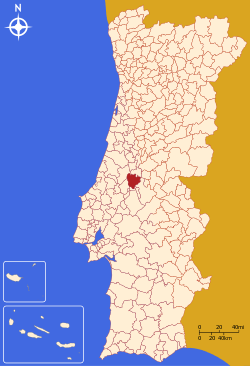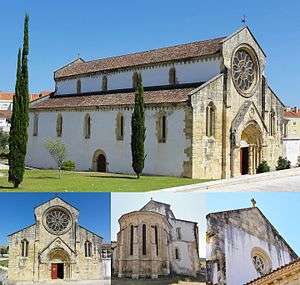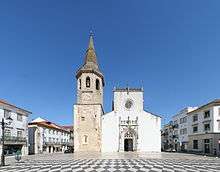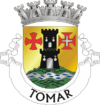Tomar
| Tomar | |||
|---|---|---|---|
| Municipality | |||
|
View of the old town of Tomar and the Nabão river | |||
| |||
 | |||
| Coordinates: 39°36′N 8°25′W / 39.600°N 8.417°WCoordinates: 39°36′N 8°25′W / 39.600°N 8.417°W | |||
| Country |
| ||
| Region | Centro | ||
| Subregion | Médio Tejo | ||
| Intermunic. comm. | Médio Tejo | ||
| District | Santarém | ||
| Parishes | 11 | ||
| Government | |||
| • President | Anabela Freitas[1] (PS) | ||
| Area | |||
| • Total | 351.20 km2 (135.60 sq mi) | ||
| Population (2011) | |||
| • Total | 40,677 | ||
| • Density | 120/km2 (300/sq mi) | ||
| Time zone | WET/WEST (UTC+0/+1) | ||
| Website | http://www.cm-tomar.pt | ||
Tomar (Portuguese pronunciation: [tuˈmaɾ]), also known in English as Thomar, is a city and a municipality in Santarém District in Portugal. The town proper has a population of about 20,000. The municipality population in 2011 was 40,677,[2] in an area of 351.20 km².[3]
The town of Tomar was born inside the walls of the Convento de Cristo, constructed under the orders of Gualdim de Pais, the fourth grand master of the Knights Templar in the late 12th century.
Tomar is one of Portugal's historical jewels and more significantly was the last Templar town to be commissioned for construction. Tomar was especially important in the 15th century when it was a centre of Portuguese overseas expansion under Henry the Navigator, the Grand Master of the Order of Christ, successor organization to the Templars in Portugal.
Geography
Tomar lies in the most fertile region of Portugal, and one of the most fertile in the whole of the Iberian Peninsula: the Ribatejo ("by the river Tagus") meadows. It is located in the district of Santarém. The predominant treescape is agricultural, consisting of olive, pine and fig trees.
The seat of the municipality is the city of Tomar, which comprises the parishes of Santa Maria dos Olivais and São João Batista. Tomar is also the capital of the Médio Tejo (Mid-Tagus river) region.
The Nabão River cuts across what was the ancient city of Nabantia: its inhabitants are called Nabantinos.
Parishes
Administratively, the municipality is divided into 11 civil parishes (freguesias):[4]
- Além da Ribeira e Pedreira
- Asseiceira
- Carregueiros
- Casais e Alviobeira
- Madalena e Beselga
- Olalhas
- Paialvo
- Sabacheira
- São Pedro de Tomar
- Tomar (São João Baptista) e Santa Maria dos Olivais
- Serra e Junceira
History
Under the modern city lies the Roman city of Sellium. After the conquest of the region from the Moors in the Portuguese Reconquista, the land was granted in 1159 as a fief to the Order of the Knights Templar. Its Grand Master in Portugal, and Tomar's somewhat mythical founder, Gualdim Pais, laid in 1160 the first stone of the Castle and Monastery that would become the headquarters of the Order in Portugal. Local traditional legends preach that the choice was for mystical reasons and by divine inspiration, from practices like geomancy by the Grand Master, based on exercises taken from luck and predestination. Reinforcing this magical view is the fact that the lot was part of a small chain of seven elevations (lugar dos sete montes), which became known as the city of seven hills, as the seven hills of Jerusalem, the seven hills of Rome or the seven columns of Constantinople.[5]
The foral or feudal contract was granted in 1162 by the Grand Master to the people. The Templars ruled from Tomar a vast region of central Portugal which they pledged to defend from Moorish attacks and raids. Like many lords of the unpopulated former frontier region of central Portugal, the villagers were given relatively liberal conditions in comparison with those of the northern regions of Portugal, in order to attract new immigrants. Those inhabitants who could sustain a horse were obliged to pay military service in return for privileges. They were not allowed the title of Knight which was reserved to the monks. Women were also admitted to the Order, although they didn't fight.
In 1190 Abu Yusuf al-Mansur, a Moroccan caliph, and his army attacked Tomar. However the crusader Knights and their 72-year-old leader kept them at bay. A plaque commemorates this bloody battle at the Porta do Sangue at the Castelo Templário (Castle of Tomar).

In 1314, under pressure from the Pope Clement V, who wanted the Templars banned throughout Europe, King Dinis negotiated instead to transfer the possessions and personnel of the Order in Portugal to a newly created Order of Christ. This Order in 1319 moved south to Castro Marim, but in 1356 it returned to Tomar. In the 15th century the position of (cleric) Grand Master of the Order was henceforth nominated by the Pope, and the (lay) Master or Governor by the King, instead of being elected by the monks.
Henry the Navigator was made the Governor of the Order, and it is believed that he used the resources and knowledge of the Order to succeed in his enterprises in Africa and in the Atlantic. The cross of the Order of Christ that was painted in the sails of the caravels that crossed the seas, and the Catholic missions in the new lands were under the authority of the Tomar clerics until 1514. Henry, enriched by his overseas enterprises, was the first ruler to ameliorate the buildings of the Convento de Cristo since its construction by Gualdim Pais. He also ordered dams to be built to control the river Nabão and swamps to be drained. This allowed the burgeoning town to attract more settlers. Henry ordered the new streets to be designed in a rational, geometrical fashion, as they can still be seen today.
In 1438, King Duarte, away from Lisbon because of the Black Death, died there instead.


Just after 1492 with the expulsion of the Jews from Spain, the town increased further with Jewish refugee artisans and traders. The very large Jewish minority dynamized the city with new trades and skills. Their experience was vital in the success of the new trade routes with Africa. The original synagogue still stands.
In the reign of Manuel I of Portugal the convent took its final form within the Manueline renaissance style. With the growing importance of the town as master of Portugal's overseas empire, the leadership of the Order was granted to the King by the Pope.
However, under pressure from the Monarchs of Spain, the King soon proclaimed by Edict that all the Jews remaining within the territory of Portugal would be after a short period considered Christians, although simultaneously he forbade them to leave, fearing that the exodus of Jewish men of knowledge and capital would harm Portugal's burgeoning commercial empire. Jews were largely undisturbed as nominal Christians for several decades, until the establishment of a Tribunal of the Portuguese Inquisition by the initiative of the Catholic Clergy in the town. Under persecution, wealthier Jews fled, most others were forced to convert. Hundreds of both Jews and New Christians were arrested, tortured and burned at the stake in autos da fé, in a frenzy of persecution that peaked around 1550. Many others were expropriated of their property. Jewish ascendancy, more than Jewish religion, together with personal wealth determined whom would be persecuted, since the expropriations reverted to the institution of the Inquisition itself. The town lost then with the persecution of its merchants and professionals most of its relevance as a trading centre. New Christian names among the inhabitants are very common today.
In 1581 the city was the seat of the Portuguese Cortes (Feudal Parliament) which acclaimed the King of Spain Felipe II as Portugal's Filipe I.
During the 18th century Tomar was one of the first regions of Portugal in industry. In the reign of Maria I, with royal support, a textile factory of Jácome Ratton was established against the opposition of the Order. The hydraulic resources of the river Nabão were used to supply energy to this and many other factories, namely paper factories, foundries, glassworks, silks and soaps.
Tomar was occupied by the French during the Napoleonic invasions, against which it rebelled. Duke of Wellington with his Portuguese and English troops liberated the city afterwards.
In 1834 all the religious orders, including the Order of Christ, were disbanded.
Attractions


Tomar attracts many tourists because of its varied monuments. These include:
- Magnificent ensemble of 12th- to 16th-century architecture and art, it is the main monument of the city and one of the most important in Portugal.
- Aqueduct of Pegões - It was built in the sixteenth century and 17th century to bring water to the convent of Christ in Tomar under command of king Philip I. It's an amazing monument with 6 kilometers, and in places it reaches a height of 30 meters. The construction started in 1593 and finished in 1614 and it is the biggest and most important construction of the Philip I kingdom in Portugal. You can take the small "train tour bus" in the city center that takes you to the highest point of the monument.
- Church of Santa Maria do Olival: This Gothic church (13th century) was built as burial ground for the Templar Knights and their treasure. The great importance of the church in medieval times is proven by the existence of a papal bull, even during the last period Templar, who put this temple is directly dependent on the Pope, outside the purview of any diocese. Later, through two bulls, one of Pope Nicholas V (1454) and another of Pope Callistus III (1456), was granted or obligation given to the Order of Christ to establish the spiritual duty on all lands found by the Kingdom of Portugal, territories as "DIOCESIS nullius", making this See of all the parish churches of the territories found in Asia, Africa and America mother and being given the honor of the Cathedral.
- Synagogue of Tomar: Tomar has the best preserved mediaeval synagogue of Portugal. It was built in the mid-15th century by Prince Henry The Navigator, and has an interesting interior with Gothic vaulting and columns with classic capitals. Since 1939 it houses the small Jewish Museum Abraão Zacuto, with interesting pieces related to Jewish history in Portugal.
- Church of Saint John the Baptist (São João Baptista): The main church of Tomar is located in the main square of the town, in front of the Municipality (17th century) and a modern statue of Gualdim Pais. The church was built between the 15th and 16th centuries and has many interesting artistic details, like the flamboyant Gothic portal, the Manueline tower with a 16th-century clock, the decorated capitals of the inner columns of the nave and several panels painted in the 1530s by one of Portugal's best Renaissance artists, Gregório Lopes.
- Chapel of Our Lady of the Conception (Nossa Senhora da Conceição): Chapel built between 1532 and 1540 in pure Renaissance style, begun by João de Castilho and finished by Diogo de Torralva. It was intended to be the burial chapel of King John III. Its beautiful and clear architecture turns it into one of the best early Renaissance buildings in Portugal. It's one of the first Maneirist Monuments of all Europe.
- Church and Convent of Saint Iria: Located near the Nabão river, this early 16th-century building has a nice Renaissance portal and altar, as well as Manueline architectonic details.
- Museu dos Fosforos (Matchbox Museum) - The biggest private matchbox collection in Europe
- Museu de Arte Moderna - Colecção José Augusto França (Art Gallery)
- Casa Museu Fernando Lopes Graça
- Casa dos Cubos (Art Gallery)
The streets and squares of the picturesque centre of Tomar are organised following a chessboard pattern, a rare feature for a mediaeval city, instituted by Prince Henry The Navigator, which later inspired the pattern used for the rebuilding of Lisbon after the Earthquake in 1755. Scattered throughout the town there are many interesting houses with Renaissance, Baroque and Romantic façades. By the river Nabão, near the bridge, there is a park and garden that offer nice views of the city and surroundings.
Myths
- It is rumored that Tomar hides the world's greatest templar treasure (L'or des Templiers: Gisors ou Tomar? Maurice Guinguand, 1973)
- It is rumored that there is a secret passageway between the Santa Maria dos Olivais church and the Castle.
- The Castle of Almourol nearby is where several bad events (deaths and tragic love stories) have taken place and is supposed to be haunted by a princess.[6]
Schools and Education
Tomar has several schools including primary, junior high school, high schools and a Politechnic. These include:
- Escola do 1º Ciclo dos Templários - Primary school
- Escola do 1º Ciclo de Santo António - Primary school
- Escola do 1º Ciclo de Infante D. Henrique - Primary School
- Escola do Ensino Básico 2+3 Gualdim Pais- Junior High School
- Escola do Ensino Básico 2+3 D. Nuno Álvares Pereira - Junior High School, Former High School and The oldest one in the town.
- Escola do Ensino Básico 2+3 de Santa Iria- Junior High School
- Escola Secundária Santa Maria do Olival - High School
- Escola Secundária Jácome Ratton- High School
- Instituto Politécnico de Tomar- Politechnic
Holidays
The Municipal holiday day is March 1, and commemorates the day when the Templars Master D.Gualdim founded the Templar City in 1160.
Local Festival and Events
- Festa dos Tabuleiros (Trays Festival), an ancient tradition in Tomar, is the most important festival celebrated in the city, attracting people from all over the world. The festival is held every four years, the last being held in June and July 2015. The local population parades in pairs with the girls carrying tabuleiros on their heads. The tabuleiro is made of 30 stacked pieces of bread, either in 6 rows of 5 or 5 rows of 6, decorated with flowers. At the top of the tabuleiro is a crown which normally contains either a white dove, symbolising the Holy Spirit, or the esfera armilar (armillary sphere), a symbol of the historical Portuguese maritime expansion.
- Festa de Santa Iria
- Nossa Senhora da Piedade (Religious Festival) - Held on first Sunday in September
- Festival Estatuas Vivas de Tomar
- Congress of Soups of Tomar
- Festival Bons Sons (Cem Soldos) - One of the most popular Portuguese Music Festivals (biennial)
- Festival Internacional de Tunas da Cidade de Tomar
- Tomarimbando - Festival de Percussão de Tomar
- Feira da Laranja Conventual
- Beer Fest of Tomar
- Summer fests in Tomar district - Serra Tomar is the largest one
- Remember PimPim (80's music festival)
- Knights Templar Festival
Local Food Specialities
- Fatias de Tomar
- Beija-me depressa (kiss me quickly) - Estrelas Confeitery
Sports Activities
- União de Tomar - Football
- Rugby Clube de Tomar - Rugby
- Tenis Clube de Tomar - Tennis
- Centro Hípico Quinta de Azinhais - Hiking
- Sporting de Tomar - Hockey on Rollerblades
- SF Gualdim Pais - Gymnastics, Swimming
- Ginasio Clube de Tomar - Gymnastics
- Associação Tomarense de Aviação Ultraligeira (ATAUL) - Aviation
- AeroCalminhas - Aeromodelism
- Pantanal Club - Nutic modelism
- Associação de Natação do Distrito de Santarém (Headquarters in Tomar) - Swimming
- Motor Clube de Tomar - Motocross and Off-Road
- Clube TT Minjoelho - Off-Road
- Automovel Clube de Tomar - Car Rally
- Clube Amadores de Pesca de Tomar - Fishing
- Clube de Caça e Pesca da Zona dos Templários - Hunting and Fishing
- CALMA, Clube de Actividades de Lazer e Manutenção - Running, Riding
- Clube Columbófilo Tomarense - Columbofilia
- Grupo Desportivo da Nabância - Canooing
- Aventura Templar - Nautic Sports, Boat rental, Sky, PaintBall, etc...
- SCOCS(Sport Clube Operário Cem Soldos) - Judo
- O Vale dos Cavalos - horse riding lessons, trail riding and horse holidays
Films shot in Tomar
- 2014 A Porta 21, directed by João Marco (with Mário Spencer, Pedro Monteiro, Pedro Viegas)
- 2011 Pão Nosso (Documentary), directed by Mónica Ferreira, João Luz
- 2009 Juan de Castillo constructor del mundo (Documentary), directed by Alberto Luna Samperio (Etnocantabria)
- 2009 La reine morte, directed by Pierre Boutron (with Michel Aumont, Gaëlle Bona, Thomas Jouannet)
- 2007 Teresa, el cuerpo de Cristo, directed by Ray Loriga (with Paz Vega, Leonor Watling, Geraldine Chaplin, Eusebio Poncela)
- 2007 Infante D. Henrique (Documentary), directed by José Francisco Pinheiro (with Gonçalo Cadilhe)
- 2006 Coach Trip (TV Series), directed by Amanda Wood (with Brendan Sheerin, Andy Love)
- 2005 Pedro e Inês (TV Series) (with Pedro Laginha, Ana Moreira, Nicolau Breyner)
- 2004 O Quinto Império - Ontem Como Hoje, directed by Manoel de Oliveira (with Ricardo Trêpa, Luís Miguel Cintra, Glória de Matos)
- 2003 Volpone, directed by Frédéric Auburtin (with Gérard Depardieu, Daniel Prévost, Gérard Jugnot, Robert Hirsch)
- 2001 Quem És Tu?, directed by João Botelho (with Patrícia Guerreiro, Susana Borges, Rui Morisson, Rogério Samora, José Pinto, Francisco D'Orey e Bruno Martelo)
- 1985 Atlântida: Do Outro Lado do Espelho, directed by Daniel Del Negro (with Luís Lucas, Teresa Madruga, Ruy de Carvalho)
- 1922 A Sereia de Pedra, directed by Roger Lion (scenes shot in June and July 1922 at the Convento de Cristo and Ruinas do Castelo dos Templarios)
See also
References
- ↑
- ↑ Instituto Nacional de Estatística
- ↑ Direção-Geral do Território
- ↑ Diário da República. "Law nr. 11-A/2013, pages 552 119-120" (pdf) (in Portuguese). Retrieved 31 July 2014.
- ↑ - TOMAR DOS TEMPLÁRIOS: A SEDE PORTUGUESA DA ORDEM DOS TEMPLÁRIOS - Ademir Luiz da Silva, Revista Mosaico, v.4, n.1, p.92-103, jan./jun. 2011 - in Portuguese
- ↑ Description of Tomar
External links
| Wikimedia Commons has media related to Tomar. |
| Wikisource has the text of the 1911 Encyclopædia Britannica article Thomar. |
- City Hall official website
- Tomar.com.sapo.pt
- The Thomar Vrbe Project
- The Synagogue of Tomar
- Photos from Tomar

